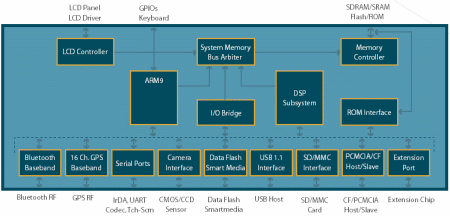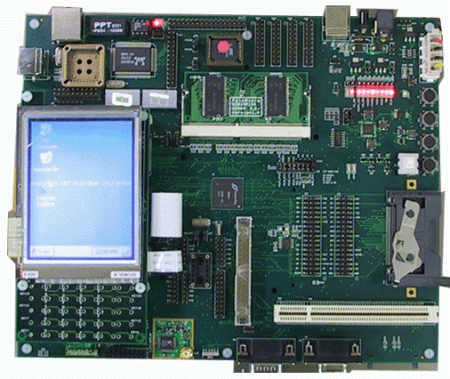Ultra-integrated system-on-chip challenges XScale, SH, OMAP
Apr 18, 2003 — by LinuxDevices Staff — from the LinuxDevices Archive — 2 views[Updated Apr. 21, 2003] — Centrality Communications (Santa Clara, CA) unveiled a new family of ultra-integrated dual-core system-on-chip processors intended for use in next-generation wireless and GPS-enabled devices such as smartphones, PDAs, and automotive navigation/telematics systems. According to Centrality, its new “Atlas” processors integrate the equivalent capabilities of up to six chips into a single piece of silicon, including an ARM9 RISC processor, a DSP for communications and other control functions, a graphical LCD controller, Bluetooth and GPS baseband controllers (external RF circuits required), a digital camera interface, and a long list of peripheral control and system expansion interfaces.
Two versions of the Atlas processor are currently available, based on the same die but with differing temperature ranges, packaging, and firmware suites, the company said. The Atlas-M is for mobile applications and has a standard commercial temperature rating, while the Atlas-A targets automotive applications and is rated for industrial temperatures (-45C to +85C).

Atlas block diagram (click to enlarge)
Both versions are said to include the following dizzying set of functions . . .
- CPU: 240MHz ARM9 RISC processor (includes MMU)
- DSP: 120MHz DSP for communications, GPS and multimedia functions
- Memory:
- Built-in function for system bootstrap from external NAND Flash
- Direct-connect interface to external memory chips, including: Mobile SDRAM, SDRAM, NAND, and NOR Flash
- Built-in function for system bootstrap from external NAND Flash
- GPS: 16-Channel GPS baseband controller with high sensitivity and WAAS/EGNOS (requires external RF circuitry)
- Bluetooth: Bluetooth 1.1 baseband controller (requires external RF circuitry)
- LCD controller: glueless interface to LCDs of up to 640×480 pixels (currently limited to 320×240, based on available firmware)
- Digital camera controller: provides image processing support up to 1.3M/2.1M pixel resolutions
- I/O interfaces:
- 3 16550-compatible UARTs
- Glueless USB 1.1 client port
- IrDA interface
- Touch screen CODEC interface
- Audio: I2S, AC97
- Glueless ATAPI/IDE interface
- 3 16550-compatible UARTs
- Expansion card interfaces:
- SD/MMC
- CompactFlash/PCMCIA
- SmartMedia
- SD/MMC
The on-chip DSP is used for accelerating specific applications, such as voice over IP (VoIP), MP3, image compression, and video processing.
Centrality also offers a reference platform for the Atlas processor, which includes a single-board computer that brings out all the chip's functions to connectors (shown below), a 3.5-inch touch-panel LCD (also shown in the photo), and a “complete” BSP (board support package) for Windows CE 4.2 that comes with relevant kernel, drivers, and sample code for GPS, Bluetooth, and Digital Camera functionality, the company said.

Centrality said it provides device drivers for GPS, Bluetooth, Camera, PCMCIA, USB, Power Management, Display, touch panel, audio, keypad, SmartMedia/NANDFlash storage, DSP, PCMCIA, SD/MMC, serial, power button, virtual serial port, gyro, odometer, temperature sensor, and IDE/ATAPI functions. “OEM adaptation kits” for Microsoft's Windows Automotive 4.2, PocketPC, and Smartphone embedded operating system platforms will also be offered by Centrality.
Although operating system support directly from Centrality is limited to Microsoft embedded OSes, arrangements are in process for a third-party port to embedded Linux, a company source said.
The Atlas processors and associated reference platform are said to be available in sample quantities now, with volume production expected by mid-2003. The price for the reference platform is $3,800.
This article was originally published on LinuxDevices.com and has been donated to the open source community by QuinStreet Inc. Please visit LinuxToday.com for up-to-date news and articles about Linux and open source.